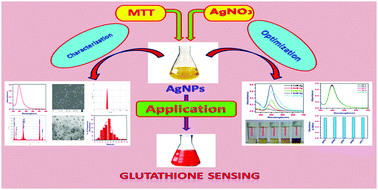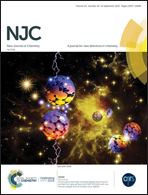The synthesis of thiol-stabilized silver nanoparticles and their application towards the nanomolar-level colorimetric recognition of glutathione†
Abstract
A highly responsive and selective patterning nanomaterial was developed based on 5-methyl-1,3,4-thiadiazole-2-thiol fabricated silver nanoparticles with the simplicity of colorimetric performance. The assay is a reliable tool for the selective detection of glutathione (GSH), which is known as “the mother of all antioxidants” as well as a principle detoxifier in the human detoxification system. The newly synthesised silver nanoparticles were characterised through various spectroscopic and microscopic techniques. The probe exhibits superb selectivity towards GSH in the presence of other bio-molecules. During the addition of GSH, the colour of the yellow probe gradually changes to pale red along with an appropriate absorption response. A fast, selective and sensorial sensing platform for ultra-trace detection of GSH with a lower statistical detection limit of 3.49 nM and a linearity range from 0.05 μM to 5 μM is established with the sensor. The probe is effectively exploited to detect GSH in some GSH-containing capsules as well as human urine samples and is recovered with almost 100% accuracy; thus, it is a feasible colorimetric GSH detector in real-time sample analysis.



 Please wait while we load your content...
Please wait while we load your content...